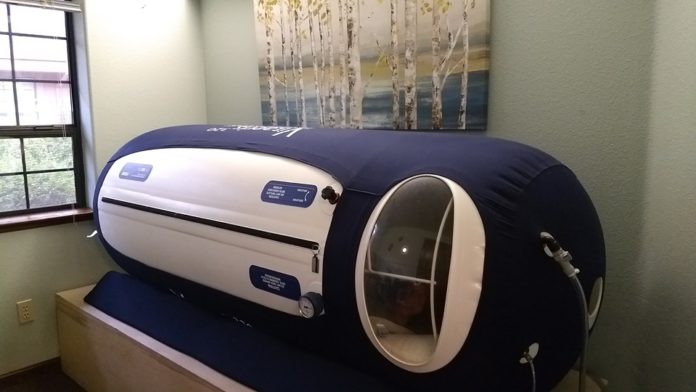The coronavirus pandemic originated in the Wuhan city of China in 2019. We are still fighting with this deadly disease without a prominent drug or medication. The reason behind the inability to find a possible and promising medication is the unpredictable nature of the disease. In every patient, COVID-19 can create different symptoms. These symptoms may include cough, fever, headache, etc.
However, one of the common symptoms in the most severe and critical COVID-19 cases is respiratory blockage and pneumonia. Once the patient starts developing progressive pneumonia, the need for ventilation or intubation increases every hour. If the patient is moved to the ventilator or offered intubation support for proper breathing, the mortality rate increases.
At this stage, there are very few medication options. The supportive care that helps non-severe cases to recover doesn’t offer help in severe and critical cases.
Here, hyperbaric oxygen therapy can be utilized to reduce pneumonia or progressive hypoxia in critical and severe COVID-19 cases. HBOT therapy helps in delivering more oxygen to the body, which can relieve hypoxia internally without intubation. Below we have discussed how that is possible. Read more to know more about this COVID-19 treatment option.
What is Hyperbaric Oxygen Therapy?
Hyperbaric oxygen therapy is a treatment that provides 100% oxygen to the body. When the patient is not in the chamber, the body carries oxygen via red blood cells only. However, once in the hyperbaric chamber, the oxygen level, and pressure increases. This increase in oxygen and pressure helps the body fluids to carry oxygen. For instance, instead of just red blood cells, cerebral spinal fluids, lipids, and plasma also start carrying oxygen. With an increase in oxygen, hypoxia is treated from the core.
HBOT therapy is an FDA-approved treatment for various diseases such as necrotizing fasciitis, wound healing, etc. It is also being used for many off-label treatments, such as autism and COVID-19. However, an off-label treatment doesn’t indicate that HBOT is not suitable. It just indicates that HBOT treatment for this disease is not yet approved by the FDA.
Studies of Wuhan China
In Wuhan, China, a study was carried out at the Opelousas General Health System. Here, HBOT therapy was first considered when a 48-year-old woman came for treatment. She had severe hypoxia and a breath rate of only 50 breaths in one minute. Needless to say, her oxygen saturation was poor. It was falling continuously.
When the woman was to be moved to intubation, the pulmonologist decided to try hyperbaric oxygen therapy for COVID-19. As a result, the patient received a 90-minute session at 2 ATA. After just the initial session, her breath rate improved and hypoxia decreased. Fortunately, the patient was stabilized in just 24 hours. In the next 5 days, the same patient received the complete course of HBOT, which improved her condition. She is no more at the danger of COVID-19.
Between this duration, 4 more patients visited the unit for HBOT treatment. All of these patients are now in better condition. There oxygenation level is good and breaths per minute are also favorable.
However, as per many scientists, HBOT therapy for COVID-19 still has risks. Therefore, this therapy is only considered if the patient is to be intubated in the next few hours. So, right before the ventilation, the patient is given HBOT therapy to reduce hypoxia and improve the condition.
How to Mitigate Risks?
There are multiple risks of the therapy, which can be mitigated with controlled measures. Here are the risks:
- The transporting of the patient from and to the HBOT chamber.
- Release of HBOT air in a safe area to reduce the spread of infection.
- Monitoring of COVID-19 patients to avoid complications of high pressure.
These risks can be eliminated with the following measures:
- Training HBOT attendants to carefully conduct the therapy.
- Disinfecting the chamber after use by one patient to avoid cross-transmission.
- Using proper gear near a COVID-19 patient.
- Offering masks and other gear to the patient, which should not be removed during the therapy.
- Limiting the number of people who are accompanying the patient to the therapy.
- Measuring body temperature and other health markers for healthy patients.
- Keeping separate HBOT units and wards for COVID-19 and non-COVID-19 patients.
- Proper use of hand-sanitizer to avoid the unintentional spread of the virus.
- Creating a proper mechanism for disposing of air released from the HBOT chamber to avoid spreading of the virus.
- Using dedicated face masks for every COVID-19 patient admitted for HBOT.
- Taking necessary precautions while transporting the patient to and from the chamber.
Conclusion
COVID-19 pandemic is spreading at an alarming rate. Even with multiple weeks of lockdown, major countries are unable to keep the situation under control. Especially for severe and critical cases, there’s no prominent medication option once the patient is moved to intubation. HBOT therapy can help in delivering optimum oxygen to the lungs without harming the body. This is why HBOT treatment is being researched for its effectiveness in COVID-19 across the globe.
However, since this treatment is still in initial phases for COVID-19, it is not suggested to try it at home. It is best to consult a doctor before moving ahead with this decision.









